
95% of researchers rate our articles as excellent or good
Learn more about the work of our research integrity team to safeguard the quality of each article we publish.
Find out more
ORIGINAL RESEARCH article
Front. Earth Sci. , 09 January 2023
Sec. Structural Geology and Tectonics
Volume 10 - 2022 | https://doi.org/10.3389/feart.2022.1033344
This article is part of the Research Topic Quantitative Characterization and Engineering Application of Pores and Fractures of Different Scales in Unconventional Reservoirs – Volume II View all 39 articles
In recent years, oil and gas exploration of the Baikouquan Formation in the northwestern margin of the Junggar Basin has seen major breakthroughs have been made in oil and gas exploration. Sandstone and conglomerate reservoirs are developed in the Baikouquan Formation in this area, but the factors affecting the differences in petro physical properties of these two types of reservoirs are still unclear. In this paper, taking the Baikouquan Formation in the Hongcheguai area on the northwestern margin of the Junggar Basin as an example, a large number of core observations, thin sections, scanning electron microscopy, and petro physical property test data were used to evaluate the petro logical characteristics, reservoir space types, digenesis and pore evolution of the sandstone and conglomerate reservoirs. The results show that the sandstone and conglomerate rocks of the Baikouquan Formation in the study area have a large content of tuffaceous components. The sandstone reservoirs are dominated by primary intergranular pores, and the conglomerate reservoirs are dominated by secondary dissolved pores. In addition, the porosity is negatively correlated with rock permeability for the conglomerate rocks of the Baikouquan Formation. However, the porosity is positively correlated with rock permeability of the sandstone reservoirs. According to the analysis of the digenetic process, the compaction and cementation can lead to a significant decrease in the petro physical properties of the reservoir. While dissolution can improve the petro physical properties of the sandstone reservoirs to a small extent, and can improve that of the conglomerate reservoirs to a greater extent. Moreover, local fractures are important factors affecting the petro physical properties of the conglomerate reservoirs. The existence of abnormal high pressure has a certain effect on the preservation of primary pores. On the whole, the controlling factors of the petro physical properties of the conglomerate reservoirs in the Baikouquan Formation include sedimentation, diagenesis, and tectonic actives, while that of the sandstone reservoirs mainly include sedimentation and diagenesis.
At present, the complex lithologic reservoir is the key object of oil and gas exploration for the continental sedimentary systems in China. Conventional single genetic control methods are difficult to accurately elucidate the oil and gas enrichment laws in complex lithologic reservoirs. The petro physical properties of tight reservoirs are the comprehensive products of sedimentation, diagenesis and tectonic activities. Therefore, only by determining the influencing factors of physical properties can the accuracy of oil and gas exploration be improved (Gao et al., 2021; Liu et al., 2021). The Junggar Basin is a large-scale oil and gas-producing superimposed basin in China. The geological conditions of the northwestern margin of the Junggar Basin are complex, and the oil reservoirs with multiple lithologies are widely distributed in the Triassic (Yu et al., 2018; Meng et al., 2019). At present, the research on the Triassic reservoirs in this area is mainly concentrated in the Karamay and Baiqiantan Formations, but there is limited research on the Lower Triassic Baikouquan Formation. A systematic research on the reservoir petrology, petro physical properties, pore types and diagenesis can provide scientific guidance for efficient oil exploration and development (Lei et al., 2015; Zhang et al., 2018; Qu et al., 2019).
In recent years, with the fine oil and gas exploration of the Baikouquan Formation in the northwestern margin of the Junggar Basin, major breakthroughs have been made in oil and gas exploration. It also confirmed the possibility of large-scale lithologic reservoirs in the Baikouquan Formation. Well S1 revealed that the lithologies of oil layers include conglomerate rocks and sandstones. These two types of reservoirs are widely concerned by researchers due to their strong heterogeneity caused by diverse sedimentary environments and multiple diagenesis. The previous research mainly focused on sandstone, and the research on the reservoir properties of conglomerate rocks is still very limited (Yu et al., 2015; Qu et al., 2019). Due to the complex lithology and less analysis of controlling factors for high-quality reservoirs, the success rate of exploration wells hinders further exploration of oil and gas in this area.
In this paper, taking the Baikouquan Formation in the Hongcheguai area on the northwestern margin of the Junggar Basin as an example, core observations, thin sections, scanning electron microscopy, and petro physical property test data were used to evaluate the petro logical characteristics, reservoir space types, diagenesis and pore evolution of sandstone and conglomerate reservoirs. This research can provide new ideas for the exploration of complex lithological reservoirs in similar areas.
The Hongcheguai area is located on the northwestern edge of the Junggar Basin (Figure 1A) and is an important oil-producing area in the Xinjiang Oilfield. The target layer is the Triassic Baikouquan Formation. The Triassic stratum in the basin is a west-dipping monocline (Figure 1B). During the deposition of the Baikouquan Formation, the depositional environment of the northwestern margin of the Junggar Basin was affected by syngenetic faults and humid climate. The provenance of the Baikouquan Formation are from the northwest areas. With a small amount of volcanic activity, a large set of sandstone and conglomerate deposits of the Baikouquan Formation were formed. The Baikouquan Formation is in unconformity contact with the underlying Permian, and its thickness ranges from 200 m to 400 m.
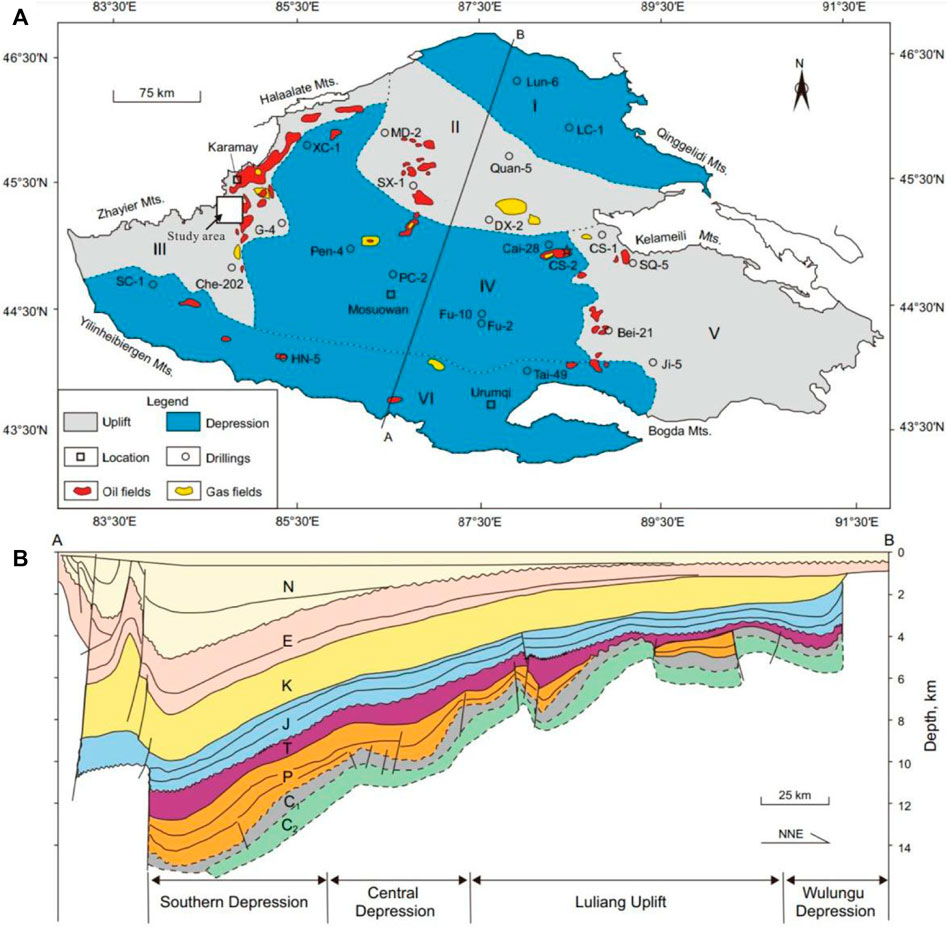
FIGURE 1. Location and strata distribution in the study area (Hu et al., 2020, modified) I. Wulungu Depression; II. Luliang Uplift; III. Western Uplift; IV. Central Depression; V. Eastern Uplift; VI. Southern Depression; Mts. Mountains. (A) The Location of Junggar Basin and study area (B) The stratigraphic section of (A,B), Which had been shown in (A).
The experiments used in this study include mercury intrusion, thin section, scanning electron microscopy, X-ray diffraction and petro physical property tests. The core diameter of the mercury injection experiment is 2.5 cm and the length is 2.0 cm. Meanwhile, the mercury porosimeter PM33GT-17 produced by Quantachrome in the United States was used. The high-pressure power system is composed of high-pressure metering pumps, the working pressure range is 0.002–50 MPa, the pressure balance time is ≥60 s, and the number of measurable pressure points reaches 100. The experiment was completed in the Xinjiang Oilfield Experimental Inspection Institute.
The sample size of the ordinary and cast thin sections is 25 mm × 5 mm. The sample was washed with oil, and the pressure of the cast rubber was 6 MPa. The experiment was completed in the Xinjiang Oilfield Experimental Inspection and Research Institute, and a total of 60 thin sections were produced.
The sample size of the scanning electron microscope is 10–15 mm in diameter and 5 mm in length. The intensity of the electron beam is 10.9 mA and the high voltage is 5 kV. According to the “Analysis Method of Rock Samples by Scanning Electron Microscope” SY/T5162-1997, 20 samples were scanned with a scanning electron microscope JSM-5500LV. The experiment was conducted at the Xinjiang Oilfield Experimental Inspection Institute.
X-ray diffraction requires grinding sandstone samples to powder. The X-ray spectrometer QUANTAX400 was used to carry out the X-ray experiments. The instrument voltage is 40 kV and the current is 250 mA. According to “Quantitative Analysis Method for Energy Spectrum of Rocks and Minerals” SY/T6189-1996, the test temperature is 20°C and the humidity is 50%. The X-diffraction experiment was completed in the Xinjiang Oilfield Experimental Inspection Institute.
Through a large number of core observations, the sandstone, conglomerate rocks, mudstone, argillaceous siltstone and silty mudstone are developed in the Triassic Baikouquan Formation in the study area. In addition, the horizontal beddings, bottom channel scouring, and massive beddings can be seen frequently in the Baikouquan Formation.
The washed channel surface (Figure 2A) is extremely developed in the target layer of the study area. At its bottom, there are directional arrangement of mud gravel components. The particle size of the mud gravel components can be up to 10 cm. They are generally formed by the scouring of the unconsolidated mudstones at the bottom of the river channels.
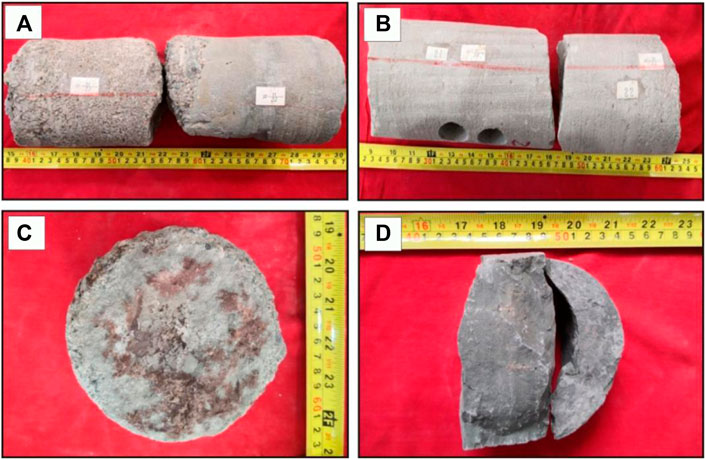
FIGURE 2. Development characteristics of different types of sandstones in Baikouquan Formation.(A) Well G6, 3024.4 m, flushed river channel surface; (B) Well G6, 3024.6 m, parallel bedding; (C) Well G103, 3307.82 m, maroon mudstone; (D) Well G6, 3025.2 m, horizontal bedding.
Parallel bedding (Figure 2B) is mainly developed in sandstones or granular limestones. Under strong hydrodynamic conditions, the sand migrates from a flat bed in a high flow state, and the continuous rolling sand on the bed produces a horizontal fine layer separated by thickness and fineness. Parallel-beddings are generally formed in rapids and high-energy environments, such as river channels and lakeshore environments (Feng., 1993; Li., 2001; Wang., 2016).
Maroon-red mudstones (Figure 2C) are less developed in the target layer in the study area, reflecting that the target layer was in a semi-oxidative-semi-reduced depositional environment during this period.
Horizontal beddings (Figure 2D) are mainly developed in fine clastic rocks. It is formed by suspended sedimentation under relatively weak hydrodynamic conditions.
Massive beddings can be seen in the coring segments of the Baikouquan Formation, and are mainly existed in siltstones, argillaceous siltstones and silty mudstones. Its internal materials are relatively uniform.
The conglomerate rocks in the Baikouquan Formation in the study area are mainly exhibit small and medium grain size, and different types of conglomerates develop in different members of the Baikouquan Formation. Among them, medium-grained conglomerate rocks are more common in the Quan 2 Member, and small-grained conglomerate is relatively developed in the Quan 3 Member (Figure 3). The main features of the conglomerate rocks in the Baikouquan Formation are: ① Most of the conglomerate is gray, with good roundness, sub-circular and sub-angular shape, and poor sorting. The comparison shows that the conglomerate rocks in the Quan 2 Member have poor sorting, and the small-grained conglomerate rocks in the Quan 3 Member have good sorting; ② Gravels have different particle sizes, some of which are more than 8 cm. The composition of the gravels is mainly magmatic rocks, followed by metamorphic and sedimentary rocks (Qiu and Xue., 1997; Ma et al., 2000).
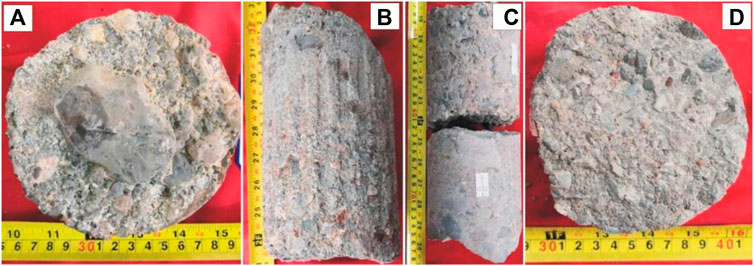
FIGURE 3. Types of conglomerate rocks in the Baikouquan Formation in the study area. (A) Well G10, Quan 2 Member, 3595.75 m, medium-grained conglomerate; (B) Well G103, Quan 2 Member, 3303.3 m, unequal-grained sandy conglomerate; (C) Well S1, Quan 2 Member, 4635.8 m, sand -containing medium grained conglomerate; (D) Well G6, Quan 3 Member, 3026.2 m, small-grained conglomerate.
The Quan 1, 2, and 3 Members of the Baikouquan Formation in the study area belong to fan delta facies. The tectonic subsidence of the Triassic in the study area is relatively large, and the terrain is in an active period and is conducive to the formation of fan deltas (Scherer., 1987; Jin et al., 2017; Hu et al., 2020). Fan delta plain deposits are widely developed in the Baikouquan Formation in the study area.
The fan delta plain deposits are mainly composed of clastic flow, distributary channel and interchannel bay deposits (Beard and Weyl., 1973; Luo., 1991; Chen et al., 2015). The lithology of the distributary channel is relatively coarse, and it is composed of gravel-bearing sandstones and pure sandstones. Gravel-bearing sandstones and pure sandstones are light gray or gray-white, and are loose and granular. Its composition is mainly quartz, followed by feldspar and a little mica, and it has several positive cyclic features that taper upwards vertically (Figure 4).
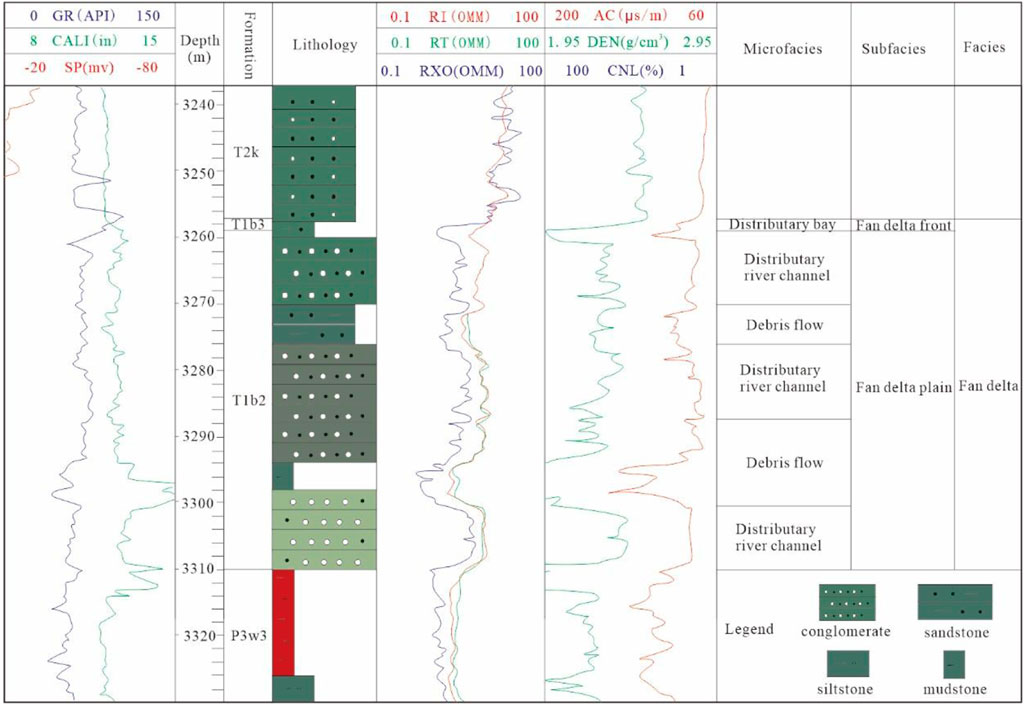
FIGURE 4. Logging response of fan delta plain micro facies in the Baikouquan Formation (T1b3 and T1b2) in Well G103.
It is mainly composed of variegated conglomerate with high content of miscellaneous matrix, poor sorting and poor roundness. In addition, they are mostly supported by matrix, arranged in a disorderly manner, and thick and massive; they are mostly distributed in the root and middle part of the fan body and in areas with large terrain slopes; and argillaceous-supported conglomerate rocks are developed (Figure 4).
It is an important micro facies type in the fan delta plain sub facies, and its deposition thickness can account for more than 70% of the plain sub facies. It is formed by frequent lateral migration and accumulation of river channel sand bars during deposition (Li et al., 2004; Yu et al., 2015; Liu et al., 2019). The grain size of the distributary channel sediments is relatively coarse, and fine-grained sediments can be seen locally. They consist of several upwardly tapering layers. The thickness of a single sequence generally ranges from 0.5 m to 4 m. Its bottom is in scouring contact, and there are sediments of gravel retained by the river bed on it (Wang et al., 2007; Wang et al., 2008; Yu et al., 2018).
It is uncommon in fan delta plains.
The reservoir properties and reservoir space types of clastic rocks vary with burial depth and diagenesis. Generally, the pore types change from shallow to deep as follows: development of primary pores → development of mixed pores → development of secondary pores → reduction of secondary pores and development of fractures. During this process, the internal structures of the rocks change from loose to dense.
Microscopic observations show that the reservoir spaces of the Baikouquan Formation sandstone and conglomerate reservoirs in the study area are mainly primary intergranular pores (Figure 5), followed by intragranular dissolved pores, microfractures, and intergranular dissolved pores. For the Quan 2 Member, the contents of primary pores and secondary pores are similar. For the Quan 3 Member, not only primary pores are mainly developed, but also micro-fractures and secondary pores are relatively developed as well.
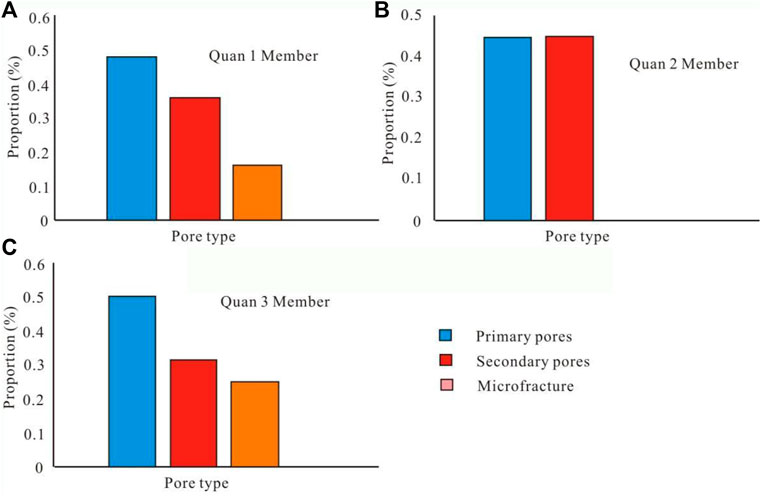
FIGURE 5. Distribution histogram of pore types in the Baikouquan Formation in the study area. (A) Quan 1 Member; (B) Quan 2 Member; (C) Quan 3 Member.
The primary pores refer to the pores preserved after the original pores have undergone a series of diagenesis such as compaction and cementation. This type of pores is common in both sandstone and conglomerate reservoirs in the Baikouquan Formation (Figure 6). Most of the remaining primary pores are polygonal pores between particles, and the pores are filled with calcite or kaolinite components.
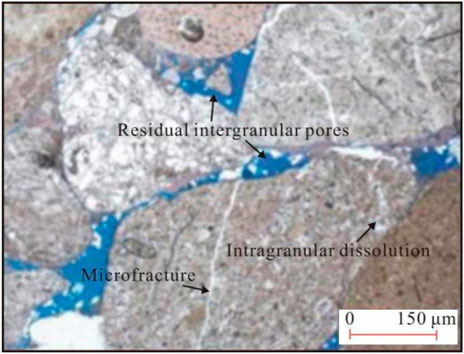
FIGURE 6. Microscopic characteristics of pore types in the Baikouquan Formation in the study area. Well S1, 4631.89m, Quan 1 Member, residual intergranular pores.
Secondary pores refer to pores formed by dissolution or compaction in sandstones. Common types of secondary pores include intragranular dissolved pores, microfractures, and intergranular dissolved pores. The main types of secondary pores in the Baikouquan Formation sandstone and conglomerate reservoirs in the study area are intragranular and intergranular dissolved pores.
Intragranular dissolved pores are mainly feldspar and detrital dissolved pores. This type of pores is common, but the connectivity is poor. The proportion of the feldspar and detrital dissolved pores accounts for 5%–10%, respectively. In addition, the intergranular dissolved pores are mainly dissolved pores formed by the dissolution of feldspar particles and intergranular calcite, zeolite and other cements, and their edges are serrated or have harbor-like form. The proportion of intergranular dissolved pores ranges from 25% to 40%.
Micro fractures are mainly formed due to the complex external stresses in the rock. Micro-fractures can be seen in the cores of the Baikouquan Formation, some of which are unfilled effective fractures, and some are completely filled with quartz. The filled quartz is mainly formed by the accumulation of silica released from the dissolution of volcanic rock debris. Quartz fillings account for 20%–30% of all fillings. The fine fractures are mainly distributed along the grain edges, which are usually effective fractures formed by the dissolution of acidic fluids. The proportion of this type of fractures is 10%.
Through statistical classification of the reservoir rocks, it is found that the reservoir rocks of the Baikouquan Formation in the Hongcheguai area are mainly conglomerate rocks, followed by sandstones (Figure 7).

FIGURE 7. Cores and microscopic images of sandstones and conglomerate rocks of the target layer in the study area. Notes: (A) Well C5, 4,068.93 m, sandstone, residual intergranular pores; (B) Well S1, 4,636.5 m, sandstone, micro-cracks; (C) Well G6, 3,026.2 m, gray conglomerate; (D) Well S1, 4,963.68 m, gray-green conglomerate.
According to the statistics of the clastic content of the sandstone samples in the Baikouquan Formation, the rock types of the Baikouquan Formation in the study area are mainly lithic sandstones. The relative mass fraction of the lithic components is 75%–80%, with an average of 77.5%. The debris components are mainly magmatic rock debris; the metamorphic rock debris components are mainly altered rocks; and the sedimentary rock debris components are mainly mudstone. In addition, the relative mass fraction of the quartz debris in the sandstones is 3%–15%, with an average of 5.25%. The quartz component is mainly composed of single crystal quartz (Figures 7A,B). Most of the single crystal quartz comes from magmatic rocks, and the secondary enlarged-edge quartz is rare in the reservoir sandstones.
The conglomerate reservoir rock types of the Baikouquan Formation mainly include small-grained and medium-grained conglomerate rocks (Figures 7C,D). The conglomerate rocks are mostly gray, and the roundness of the gravel is good. The particles are often sub-circular, sub-angular, and the overall sorting is poor. In addition, the gravels vary in size, some are more than 8 cm. The gravel compositions are mainly magmatic rocks (mainly tuff), followed by metamorphic rocks and sedimentary rocks.
The mass fraction of miscellaneous bases in conglomerate reservoirs ranges from 1% to 7%, with an average of 4.3%; the mass fraction of miscellaneous bases in sandstone reservoirs ranges from 1% to 8%, with an average content of 4.25%. The hetero-bases contained are mainly composed of mud-grade minerals. The widely distributed cement mineral components in the sandstones are mainly authigenic clay minerals (kaolinite), (iron) calcite, etc., with a small amount of laumontite and siliceous minerals. Among them, clay minerals and calcite are the main materials that act as cements for the clastic particles. The roundness of sandstone is mainly sub-edge-sub-circular, and a small amount is sub-circular and round. The structural maturity of the sandstones is better than that of the conglomerate rocks. Detritus components are generally supported by particles. The sandstone particles are mostly in point and point-line contacts. The main cementation type is contact cementation, followed by press-embedded type and press-embedded- porous type.
Reservoir petro physical properties are the main factors that determine reservoir quality and productivity (Meng et al., 2019; Tang et al., 2019). According to 66 groups of petro physical property data, the reservoir porosity of the Baikouquan Formation ranges from 4.4% to 16.69%, with an average value of 10.37%; the permeability ranges from 0.15×10–3 μm2 to 142×10–3 μm2, with an average value of 6.85×10–3 μm2. The porosity distribution range of the conglomerate reservoirs is 4.4%–16.69%, with an average value of 9.23%; the permeability distribution range is 0.15×10–3 μm2∼142×10–3 μm2, with an average value of 9.11×10–3 μm2. The conglomerate rocks appear as low-porosity and low-permeability reservoirs as a whole, but low-porosity, medium- and high-permeability reservoirs are locally developed. The comparison results show that the Petriphysical properties of conglomerate reservoirs are better than those of the sandstone reservoirs.
The correlation between the porosity and permeability of the reservoir rocks can reflect the physical characteristics of the reservoir to a certain extent. For clastic reservoirs, generally, the greater the effective porosity, the higher the rock permeability. That is, the permeability increases regularly with the increase of the effective porosity, and it reflects that the petro physical properties of clastic rock reservoirs are mainly affected by sedimentation (Xue et al., 2002; Yu et al., 2014). The porosity and permeability of the Baikouquan conglomerate show a negative correlation (Figure 8A), that is, as the porosity increases, the permeability gradually decreases. It reflects that with the increase of burial depth, the diagenetic environment of the conglomerate rocks of the Baikouquan Formation has changed greatly, and the petro physical properties of the conglomerate rocks has been greatly transformed by diagenesis, resulting in a complex relationship between rock porosity and permeability. On the whole, the porosity and permeability of the conglomerate reservoirs show a negative correlation, and the porosity and permeability of the sandstone reservoirs show a positive correlation (Figure 8B).
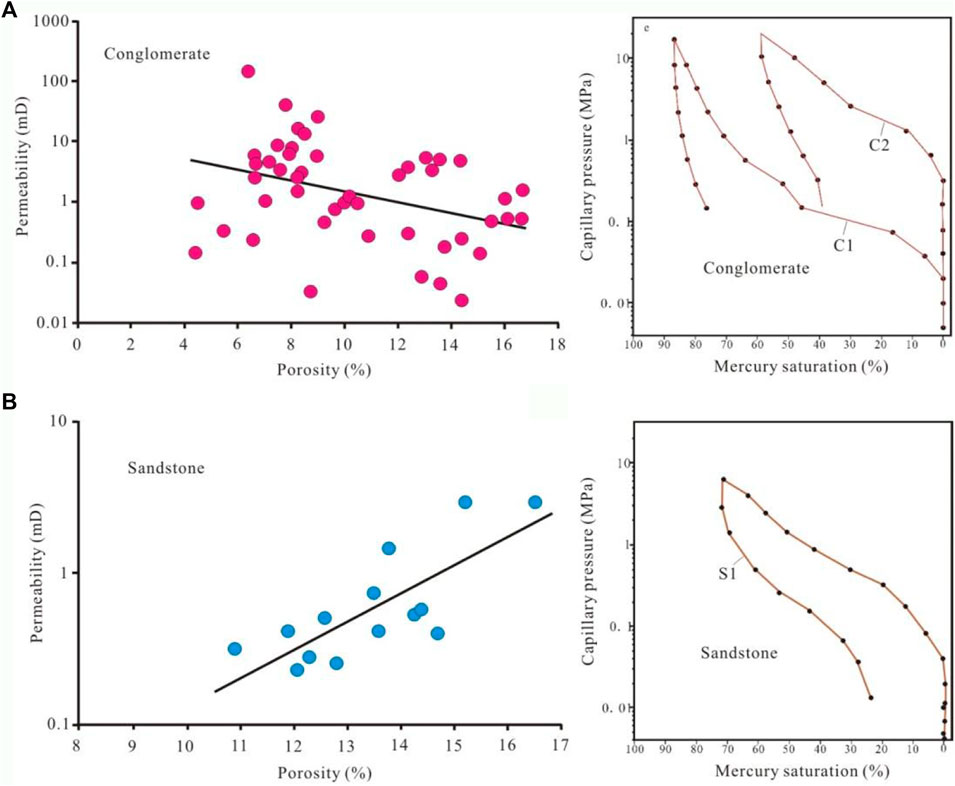
FIGURE 8. Relationship between porosity and permeability and mercury intrusion characteristics of conglomerate and sandstone reservoirs. (A) Porosity-permeability relationship(left) and mercury intrusion curve(right) of conglomerate, (B) Porosity-permeability relationship(left) and mercury intrusion curve(right) of sandstone.
From the typical curves of high pressure mercury injection in the Baikouquan Formation, it can be found that the displacement pressures of the conglomerate reservoirs are not consistent. Among them, one type is a high discharge pressure curve, which shows that the mercury saturation is low, and the mercury intake curve shows a trend of rapid growth. It reflects that there is little difference in pore structures, at the same time, the mercury removal efficiency is not high, and the small throat is not conducive to the movement of fluids inside the pores. This type of mercury injection curve is most common in sandstone reservoirs (Figure 8A, samples C1 and C2). The other type has a lower discharge pressure, which shows that the mercury saturation is relatively high, and the mercury saturation increases with the increase of the discharge pressure. It reflects that the pore structures are quite different, and the mercury removal efficiency is extremely low. Fine throats severely block the movement of fluids inside the pores (Figure 8B, sample S1). The pore structures of the sandstone reservoirs is more uniform than that of the conglomerate reservoirs in the Baikouquan Formation.
With the increase of the burial depth and the influence of sedimentation and diagenesis, the reservoir rocks have changed from loose to dense, and the petro physical properties of the reservoirs have changed significantly. At the same time, the types of storage spaces have also changed continuously. Observations and statistics of 60 thin sections of the Baikouquan Formation in the study area revealed that the reservoir space mainly includes primary intergranular pores, secondary dissolved pores and microfractures, and the primary intergranular pores are dominated (Figure 9A). Primary intergranular pores are developed in both conglomerate and sandstone reservoirs, most of which are polygonal pores among grains. In the range of burial depth of 3,000–5,000 m, the preservation of a large number of primary pores is speculated to be related to the abnormal pressures and cementation of clay minerals (Figure 9B). Secondary dissolved pores are widely developed in the conglomerate reservoirs, and they are less developed in the sandstone pores, including intragranular and intergranular dissolved pores (Figures 9C,D). Dissolved pores in grains are common in feldspar pores, and feldspar pores are usually distributed along a certain direction (along the cleavage direction). The intergranular dissolution pores are mainly formed by the dissolution of feldspar particles and intergranular calcite, zeolite and other cements. The edges of the dissolution pores are sawtooth or bay-shaped (Figures 9E,F). Microfractures are common in both conglomerate and sandstone reservoirs. The filling of quartz in structural fractures is mainly due to the accumulation of silica released by the dissolution of volcanic rock cuttings, and this type accounts for 20%–30%; the proportion of diagenetic fractures formed by acid fluid dissolution is about 10%.

FIGURE 9. Pore types and development characteristics of different minerals of the target layer. Notes: (A) Well S1, 4,631.42 m, primary intergranular pores; (B) Well J1, 4,216.68 m, secondary pores in conglomerate; (C) Well S1, 4,636.5 m, intercrystalline pores in illite in conglomerate; (D) Well S1, 4,636.5 m, secondary quartz; (E) Well S1, 4,636.5 m, dissolution pores in conglomerate; (F) Well G10, 3,596 m, joints of calcium zeolite components.
The petro physical properties of the reservoir are controlled by factors such as sedimentation, diagenesis, and tectonic processes.
The sedimentary environment of the Baikouquan Formation reservoir sandbodies in the study area is mainly fan delta system. It has diverse sedimentary micro facies, including clastic flow (distributed in fan-delta plain), underwater clastic flow (distributed in fan-delta front), distributary river channel (distributed in fan-delta plain), and underwater distributary channel (distributed in fan-delta front) (Figure 10). The oil layers are mostly distributed near the distributary river channels and underwater distributary river channel, where the sand ratio is distributed between 0.3 and 0.9. According to coring and petro physical property data, it is found that the reservoir petro physical properties in the underwater distributary river channel environment are the best, followed by the distributary river channel sand bodies, and the clastic flow and underwater clastic flow reservoirs have poor petro physical properties (Figure 11A).
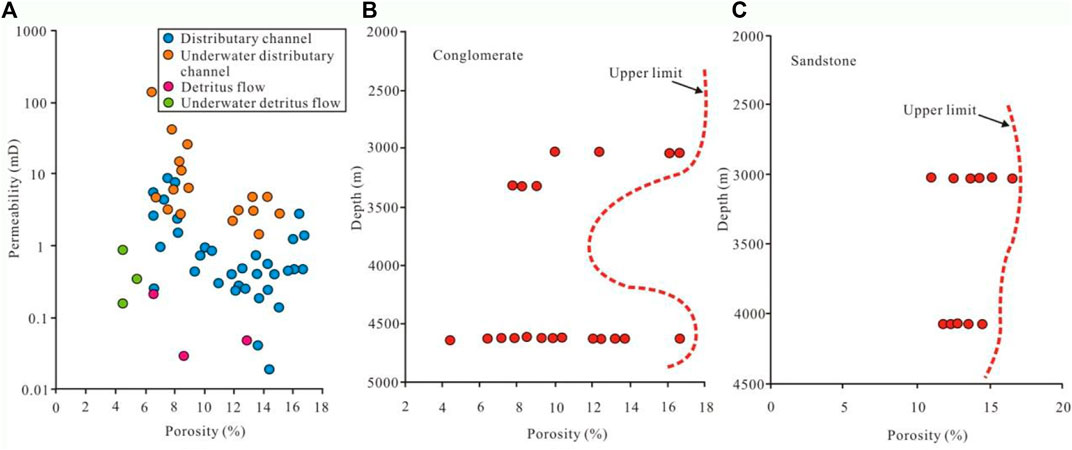
FIGURE 11. Distribution of petro physical parameters of sandstone and conglomerate in the target layer. (A) Distribution of porosity and permeability in different sedimentary microfacies, (B) Distribution of porosity with depth of conglomerate, (C) Distribution of porosity with depth of sandstone.
Affected by ancient geomorphology, provenance, and hydrodynamic conditions, the sedimentary fabric characteristics of the Baikouquan Formation (referring to particle size, clastic composition, interstitial volume fraction) are quite different. The consistency of porosity and permeability of the conglomerate reservoirs is poor. As the depth increases, the porosity and permeability tend to improve to varying degrees (Figure 11B). However, the porosity and permeability of the sandstone reservoirs decrease significantly as the depth increases (Figure 11C). The reason is that the composition of gravel is mainly tuffaceous components, and its compression resistance is weak. At the same time, the gravel particles are relatively large, and the volume fraction of the interstitials between the particles is large. Under the action of strong compaction, the primary pores are severely damaged. At a burial depth of 4,000 m, the feldspar and volcanic debris in the reservoir rocks are susceptible to dissolution, resulting in secondary pores. At the same time, the dissolution between particles improves the connectivity between pores, and the permeability of the reservoir is improved as well. Therefore, the proportion of secondary dissolved pores in the pore types of the conglomerate rocks is relatively large. The sandy particles are relatively small, and the rounding and sorting of the particles are better. Especially under strong hydrodynamic conditions, the mass fraction of mud is low. The rigid component (mainly quartz) has a large volume fraction, which offsets the impact of compaction to a certain extent. Parts of the original pores are preserved. Since the volume fraction of the shaped soluble particles is small, the later dissolution does not contribute much to the improvement of petro physical properties. Therefore, the pore types of the sandstones in the Baikouquan Formation are mainly primary pores.
The compaction of the target layer causes a loss of 50%–90% of the porosity between the primary grains. According to previous empirical formulas (Yu et al., 2022), it is calculated that the average compaction intensity of the conglomerate reservoirs is 62.6%; and the average compaction intensity of the sandstone reservoirs is 50.2%. Therefore, the degree of compaction of the conglomerate reservoirs is much higher than that of the sandstone reservoirs. According to the compaction strength classification scheme, the Baikouquan Formation in the study area belongs to the strong compaction area, which is the main factor for the deterioration of the pore structures. The mass fraction of cements was used to calculate the porosity loss caused by cementation, and it was found that the cementation caused an average loss of primary porosity of 10%. The average mass fraction of cements in the conglomerate reservoirs is 10.2%, and the average mass fraction of cements in the sandstone reservoirs is 13%. Therefore, the loss of pores caused by the cementation of sandstone reservoirs is greater than that of the conglomerate reservoirs.
After strong compaction and cementation, the primary pores in the pore type are almost destroyed. The secondary pores originate from the dissolution of particles, and the development of dissolution is of great significance to the improvement of storage properties. It can be seen from Figure 11B that with the increase of buried depth, the porosity of the conglomerate reservoirs decreases first and increases afterwards; with the increase of buried depth, the porosity of the sandstone reservoirs gradually decreases (Figure 11C). It reflects that the dissolution is of great significance to the improvement of the petro physical properties of the conglomerate reservoirs.
The development of dissolution has multi-stage characteristics. Early feldspar and plastic debris were dissolve to promote the formation of clay minerals and clay films. The development of the clay films is beneficial to slow down the compaction effect on the destruction of the primary pores, but it destroys the normal shape of the throats, resulting in a decrease in permeability and an increase in the heterogeneity of the throats. In the later period, the dissolution of calcite and pyroclastic (tuffin) is of great significance to the improvement of porosity and permeability. According to statistical results, the dissolved pore porosity of the conglomerate reservoirs increased by an average of 10%, and the dissolved pore porosity of the sandstone reservoirs increased by an average of 3%. Therefore, secondary pores are more developed in conglomerate reservoirs.
Multi-phase tectonic movements have a controlling effect on the formation of paleomorphology in the study area. The western area is a convex area, which gradually expands towards the eastern slope. The formation of the ancient landforms has an important influence on the distribution of sediments. The lower slope area of the slope break zone controls the front facies sediments and has strong hydrodynamic conditions, which is a favorable conglomerate reservoir development area.
The abnormal pressure caused by tectonic action has a certain protective effect on the development of primary pores (Figures 12A,B). The strong squeezing action causes fractures in the particles. The development of micro-fractures can be observed in the thin sectiones of the conglomerate reservoirs. Combined with fluorescent thin sections, it is found that on the one hand, fractures lead to an increase in the micro-heterogeneity of the reservoir and improve the seepage ability of fluids in low-porosity and low-permeability reservoirs. On the other hand, they provide channels for oil and gas migration and accumulation (Figures 12C,D). This is also the reason of the differences of the petro physical properties of the conglomerate and sandstone reservoirs. The controlling factors of the petro physical properties of the conglomerate and sandstone reservoirs are different. The controlling factors of the sandstone reservoirs include sedimentation (sedimentary micro facies and fabric), diagenesis, and abnormal pressure. However, the petro physical properties of the conglomerate reservoirs are also controlled by the development of fractures.
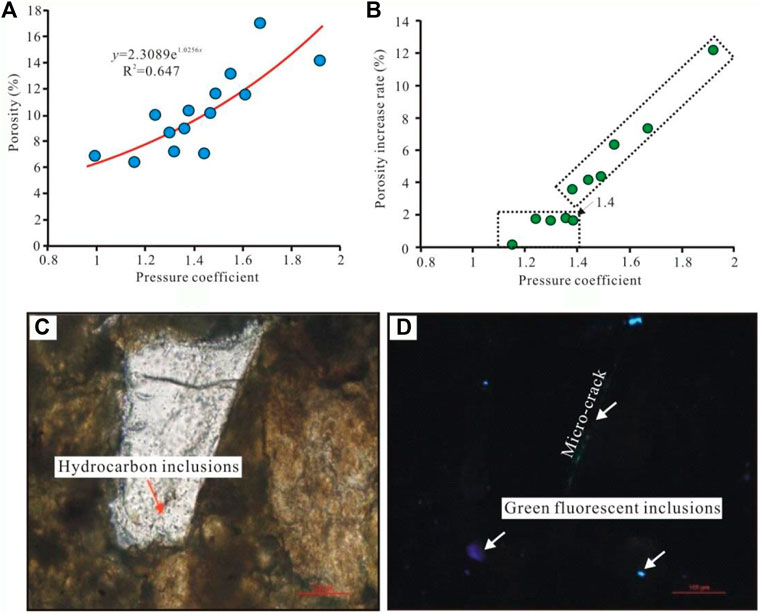
FIGURE 12. Effect of overpressure caused by tectonic action on the petro physical properties of reservoirs in the Baikouquan Formation. Notes: (A) Relationship between pore pressure and porosity; (B) Relationship between pore pressure and porosity increase rate; (C) and (D) Well S1, 4,630.56 m, hydrocarbons are distributed in bands along the micro-cracks cut through the quartz particles.
(1) The sandstone and conglomerate rocks of the Baikouquan Formation in the study area have a large content of tuffaceous components. The sandstone reservoirs are dominated by primary intergranular pores, and the conglomerate reservoirs are dominated by secondary dissolved pores.
(2) The porosity is negatively correlated with rock permeability for the conglomerate rocks of the Baikouquan Formation. However, the porosity is positively correlated with rock permeability of the sandstone reservoirs.
(3) According to the analysis of the diagenetic process, the compaction and cementation can lead to a significant decrease in the petro physical properties of the reservoir. While dissolution can improve the petro physical properties of the sandstone reservoirs to a small extent, and can improve that of the conglomerate reservoirs to a greater extent. Moreover, local fractures are important factors affecting the petro physical properties of the conglomerate reservoirs. The existence of abnormal high pressure has a certain effect on the preservation of primary pores.
(4) On the whole, the controlling factors of the petro physical properties of the conglomerate reservoirs include sedimentation, diagenesis, and tectonics, while the petro physical properties of the sandstone reservoirs are mainly controlled by sedimentation and diagenesis.
The original contributions presented in the study are included in the article/Supplementary Material, further inquiries can be directed to the corresponding author.
HK is responsible for the idea and writing of this paper and XT, JY, RZ, JW, HS, FL and HL are responsible for the data analysis.
This research was supported by the General Project of Chongqing Natural Science Foundation of China (cstc2019jcyj-msxmX0008), the Natural Science Fund of Xinjiang Uygur Autonomous Region, China (2021D01A201), and the Talent Introduction Project of Karamay campus of China University of Petroleum (Beijing) (RCYJ2016B-01-010).
Author HS was employed by the Shaanxi Yanchang Petroleum International Exploration and Development Engineering Co., Ltd. and author FL was employed by the Chongqing Gas Field, PetroChina Southwest Oil and Gas Field Company.
The remaining authors declare that the research was conducted in the absence of any commercial or financial relationships that could be construed as a potential conflict of interest.
All claims expressed in this article are solely those of the authors and do not necessarily represent those of their affiliated organizations, or those of the publisher, the editors and the reviewers. Any product that may be evaluated in this article, or claim that may be made by its manufacturer, is not guaranteed or endorsed by the publisher.
Beard, D. C., and Weyl, P. K. (1973). Influence of texture on porosity and permeability of unsolidated sand. AAPG Bull. 57 (2), 349–369.
Chen, B., Li, Z., and Su, B. (2015). Controlling factors of low permeability reservoirs of the triassic Formation in cheguai region, Junggar Basin. Nat. Gas. Geosci. 26 (S2), 73–82.
Gao, Y., Lu, Z., and Jiang, Q. (2021). Application of petro physical faciesfor sandy-conglomerate reservoir evaluation: A case upper wuerhe reservoir in the M1 well block Junggar Basin. Sci. Technol. Eng. 21 (8), 3068–3075. doi:10.3969/j.issn.1671-1815.2021.08.013
Hu, D., Rao, S., Wang, Z., and Hu, S. (2020). Thermal and maturation history for carboniferous source rocks in the Junggar Basin, northwest China: Implications for hydrocarbon exploration. Pet. Sci. 17, 36–50. doi:10.1007/s12182-019-00392-2
Jin, J., Kang, X., and Hu, W. (2017). Diagenesis and its influence on coarse clastic reservoirs in the Baikouquan Formation of Western slope of the mahu depression,Junggar Basin. Oil Gas Geol. 38 (2), 323–333+405. doi:10.11743/ogg20170212
Lei, D., Qu, J., and An, Z. (2015). Hydrocarbon accumulation conditions and enrichment regularity of low-permeability glutenite reservoirs of Baikouquan Formation in Mahu Sag, Junggar Basin. Xinjiang Pet. Geol. 36 (6), 642–647.
Li, H., Wu, T., and Wu, B. (2004). Distribution and controlling factors of high quality clastic deeply buried reservoirs in China. Geol. Sci. Technol. Inf. 23 (4), 76–82. doi:10.3969/j.issn.1000-7849.2004.04.016
Li, L. (2001). The diagenesis model of tertiary sandstone reservior in bozhong area. China Offshore Oil Gas(Geology) 15 (2), 111–119.
Liu, J., Wang, Q., and Feng, J. (2021). Complex sandstone reservoirs evaluation based on petro physical facies classification:a case study of Huizhou Sag in the Pearl River Mouth Basin. China Pet. Explor. 26 (2), 92–102. doi:10.3969/j.issn.1672-7703.2021.02.010
Liu, N., Tang, Q., and Liu, J. (2019). Microscopic heterogeneity of Toutunhe Formation and its relationship with crucial short-term base lelve cycle in Fudong slope area, Junggar Basin. Petroleum Geol. Exp. 41 (2), 234–242. doi:10.11781/sysydz201902234
Luo, Z. (1991). The theoretical approach and the case application of the control of reservoir evaluation for the clastic reservoir by means of clay minerals. J. Chengdu Coll. Geol. 18 (3), 1–11.
Ma, Q., Chen, S., Zhang, Q., and GuoWang, S. S. (2000). Overpressure basin and hydrocarbon accumulation. Beijing: Geological Publ. House, 1–29.
Meng, X., Wang, X., and Chen, Y. (2019). KE89-MAh9 paleo-salient discovery in the slope of Mahu Sag and its hydrocarbon exploration significance. Oil Geophys. Prospect. 54 (1), 217–228. doi:10.13810/j.cnki.issn.1000-7210.2019.01.025
Qiu, Y., and Xue, S. (1997). Assessment technique of hydrocarbon reservoir beijing. Beijing: Petroleum Industry Press, 59–64.
Qu, J., Yang, R., and Tang, Y. (2019). Large-area petroleum accumulation model of the triassic glutenite reservoirs in the mahu sag, Junggar Basin: Triple control of fan, fault and overpressure. Acta Geol. Sin. 93 (4), 915–927. doi:10.3969/j.issn.0001-5717.2019.04.011
Scherer, M. (1987). Parameters influencing porosity in sandstones: A model for sandstone porosity predication. AAPG Bull. 71 (5), 485–491.
Tang, Y., Guo, W., and Wang, X. (2019). A new breakthrough in exploration of large conglomerate oil province in mahu sag and its implications. Xinjiang Pet. Geol. 40 (2), 127–137. doi:10.7657/XJPG20190201
Wang, Q. (2016). Quantitative assessment of the fult-sandbody trasportability forshawan-Formation in chepaizi area of Junggar Basin. Petroleum Geol. Oilfield Dev. Daqing 35 (6), 15–20. doi:10.3969/J.ISSN.1000-3754.2016.06.003
Wang, Y., Zhong, J., and Ma, F. (2008). The mechanism of secondary porosity in the deep-seated gravel reservoirs on the steep slope belt, jiyang depression. Acta Geol. Sin. 82 (2), 1152–1160. doi:10.3321/j.issn:0001-5717.2008.08.017
Wang, Z., Li, Y., and Zhang, J. (2007). Analysis on main formation mechanisms of abnormal fluid pressure in the Upper Triassic, West Sichuan area. Oil Gas Geol. 28 (1), 43–50. doi:10.3321/j.issn:0253-9985.2007.01.006
Xue, S., Liu, W., and Xue, L. (2002). Sedimentary geology of lake basin and oil-gas exploration. Beijing: petroleum industry press, 40–41.
Yu, J., Fu, H., and Zhang, Z. (2018). Petro physical facies of toutunhe Formation in fudong slope area, Junggar Basin. Oil Gas Geol. 39 (1), 129–139. doi:10.11743/ogg20180113
Yu, J., Luo, G., and Li, B. (2022). Diagenesis and diagenetic facies of upper wuerhe Formation in the shawan sag. Geoscience 36 (4), 1095–1104. doi:10.19657/j.geoscience.1000-8527.2022.206
Yu, J., Ren, W., and Wang, W. (2015). Formation mechanism of toutunhe abnormal pressure of middle jurassic in fudong slope area, Junggar Basin. Xinjiang Pet. Geol. 36 (5), 521–525. doi:10.7657/XJPG20150504
Yu, J., Zheng, R., and Yin, X. (2014). A comprehensive research on reservoir heterogeneity of Toutunhe Formation in slope area, east of Fukang sag, Junggar Basin. J. Chengdu Univ. Technol. Sci. Technol. Ed. 41 (5), 567–576. doi:10.3969/j.issn.1671-9727.2014.05.05
Keywords: conglomerate, sandstone, reservoir, petro physical properties, controlling factors, Baikouquan formation
Citation: Kuang H, Liu H, Tan X, Yu J, Song H, Zhou R, Wang J and Liu F (2023) Study on factors affecting the petro physical properties of sandstone and conglomerate reservoirs of Baikouquan Formation, Junggar Basin. Front. Earth Sci. 10:1033344. doi: 10.3389/feart.2022.1033344
Received: 31 August 2022; Accepted: 26 September 2022;
Published: 09 January 2023.
Edited by:
Wenlong Ding, China University of Geosciences, ChinaReviewed by:
Zhonggui Hu, Sedimentology, Sequence stratigraphy, Geochemical, ChinaCopyright © 2023 Kuang, Liu, Tan, Yu, Song, Zhou, Wang and Liu. This is an open-access article distributed under the terms of the Creative Commons Attribution License (CC BY). The use, distribution or reproduction in other forums is permitted, provided the original author(s) and the copyright owner(s) are credited and that the original publication in this journal is cited, in accordance with accepted academic practice. No use, distribution or reproduction is permitted which does not comply with these terms.
*Correspondence: Hao Kuang, a3dhbmdob3dAZm94bWFpbC5jb20=
Disclaimer: All claims expressed in this article are solely those of the authors and do not necessarily represent those of their affiliated organizations, or those of the publisher, the editors and the reviewers. Any product that may be evaluated in this article or claim that may be made by its manufacturer is not guaranteed or endorsed by the publisher.
Research integrity at Frontiers

Learn more about the work of our research integrity team to safeguard the quality of each article we publish.